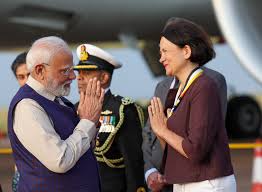PM Modi arrives in London ahead of key India-UK free trade agreement signing

Prime Minister Narendra Modi reached London on July 23, 2025, to a warm welcome from the Indian community and UK officials. His visit marks a key milestone in India-UK relations. Both nations are preparing to sign a landmark Free Trade Agreement (FTA) on July 24. This agreement is expected to reshape trade, create new opportunities, and strengthen the strategic partnership between the two countries.
The FTA comes after years of intense negotiations. It is the first major free trade deal between India and a Western economy since Brexit. For the UK, the pact aligns with its post-Brexit trade strategy. For India, it opens new global markets and boosts domestic industries.
A Warm Welcome for PM Modi
PM Modi received a heartfelt reception from the Indian diaspora, who waved tricolours and chanted slogans. “The affection of the Indian diaspora is always heartwarming,” Modi said in a brief speech. He thanked them for their support and contributions to closer India-UK ties.
During his three-day visit, Modi will meet UK Prime Minister Keir Starmer and other senior leaders. A meeting with King Charles III at Buckingham Palace is also planned. Both governments aim to use this visit to announce a “Vision 2035” roadmap, outlining joint goals for trade, climate action, education, and defense.
Key Features of the India-UK Free Trade Agreement
The India-UK FTA is among the most comprehensive trade pacts India has signed. It aims to double annual bilateral trade from $60 billion to $120 billion by 2030. Government estimates suggest the deal could add over $34 billion to trade each year.
Tariff Reductions
The agreement includes significant tariff cuts, a long-standing demand from exporters. India will eliminate tariffs on 99% of UK exports. Products like textiles, footwear, leather goods, gems, and jewellery will benefit the most.
The UK will reduce high duties on Indian products such as Scotch whisky, automobiles, and luxury goods. For instance, the 150% tariff on Scotch whisky will fall to 75% immediately and then to 40% within 10 years. Car tariffs will also drop, giving UK automobile brands better access to Indian buyers.
Boost for Services
The services sector stands to gain significantly. The FTA introduces easier visa and work-entry rules for Indian IT professionals, engineers, and healthcare workers. Meanwhile, the UK’s financial and legal services will gain a foothold in India’s growing market, particularly in fintech and insurance.
Strategic and Economic Significance
This deal is more than a trade agreement. It reflects a deeper strategic alignment between two democracies with shared global visions. The UK sees India as a high-growth market and a key technology partner. India values the UK for its advanced industries, investments, and link to broader European markets.
Post-Brexit, the UK has focused on diversifying trade partners. India’s fast-growing economy and skilled workforce make it an ideal choice. For India, the FTA supports its broader goal of creating new jobs and expanding exports worldwide.
Focus on Vision 2035
The UK-India Vision 2035 will accompany the trade deal. It sets long-term plans for cooperation in areas like:
- Technology: Joint research in AI, cybersecurity, and digital solutions.
- Defence: Enhanced collaboration in maritime security and advanced weapons systems.
- Education: More student exchanges and mutual recognition of academic qualifications.
- Climate: Shared targets for clean energy, green technology, and carbon reduction.
This roadmap will build on the Comprehensive Strategic Partnership announced in 2021.
Challenges and Future Prospects
The FTA faces some challenges despite its benefits. Critics in both countries worry about potential disruptions. Some Indian farmers fear competition from UK agricultural products. UK producers are cautious about cheap Indian goods affecting their markets.
To ease these concerns, both governments have agreed on phased tariff cuts and quotas for sensitive sectors. The deal still needs approval from the UK Parliament. India’s Cabinet has already cleared it.
Analysts believe the FTA will increase investor confidence, encourage joint ventures, and generate jobs. The IT, healthcare, and education sectors are expected to see the biggest gains.
A New Chapter in India-UK Relations
PM Modi’s visit is being seen as a turning point in bilateral relations. Both nations aim to strengthen ties beyond trade, focusing on culture, technology, and innovation. The Indian diaspora in the UK, over 1.5 million strong, plays a vital role in this partnership.
“This is not just about trade; it’s about building a partnership for the future,” said UK Prime Minister Keir Starmer. PM Modi echoed this view, calling the agreement “a reflection of the shared aspirations of our people.”
Conclusion
The India-UK Free Trade Agreement is set to begin a new era of economic cooperation. Its focus on tariff reductions, mobility for professionals, and strategic projects will benefit both countries. As PM Modi and Prime Minister Starmer prepare to sign the deal, the partnership is poised to grow into a strong alliance for the next decade.






